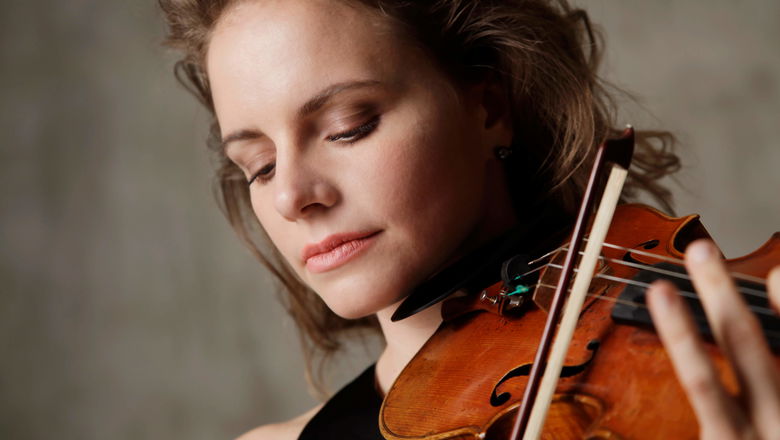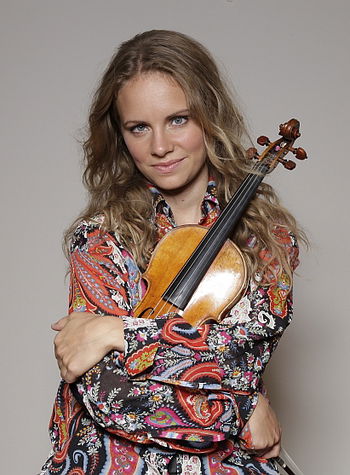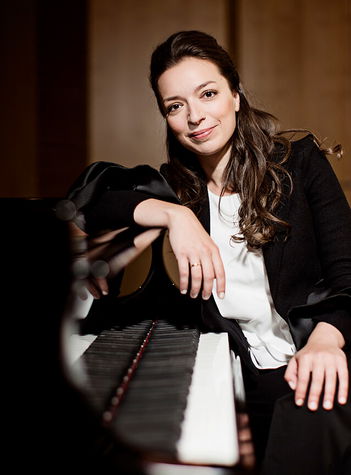Programme
Ludwig van Beethoven
Violin Sonata No. 1 in D major, Op. 12 (19')
Aram Khachaturian
Violin Sonata in G minor, Op. 1 (16')
— Intermission —
Francis Poulenc
Sonata for Violin and Piano (18')
Maurice Ravel
Tzigane (9')
Secure your seat for the 2025/2026 season – presales are open.
Choose SubscriptionOne could hardly dream of a more attractive artist than Julia Fischer to begin the recital series. A star on stages around the world and a laureate of numerous prestigious prizes, she will appear several times as this season’s curator for the Czech Chamber Music Society at the Rudolfinum.
Subscription series R | Duration of the programme 1 hour 20 minutes | Czech Chamber Music Society
Ludwig van Beethoven
Violin Sonata No. 1 in D major, Op. 12 (19')
Aram Khachaturian
Violin Sonata in G minor, Op. 1 (16')
— Intermission —
Francis Poulenc
Sonata for Violin and Piano (18')
Maurice Ravel
Tzigane (9')
Julia Fischer violin
Yulianna Avdeeva piano

After the concert we invite you to an aftertalk with Julia Fischer & Yulianna Avdeeva in the Dvořák Hall. The aftertalk will be held in English.
Host: Tereza Šindlerová
Julia Fischer violin

Julia Fischer is one of today’s most prominent violinists. Her career journey has been recorded on many CDs and DVDs on the Pentatone and Decca labels and recently also on her own musical platform JF CLUB. She has been honoured with such prestigious prizes as the Order of Merit of the Federal Republic of Germany and a Gramophone Award.
She was born in 1983 in Munich to German and Slovak parents who are said to have met while studying in Prague. She began playing the violin at age three, and she soon took up the piano as well under the guidance of her mother Viera Fischer. At just nine years of age, she enrolled at the university in Munich as a student of the renowned pedagogue Ana Chumachenco, whom Fischer later succeeded in that teaching position. A major milestone was her victory at the prestigious Yehudi Menuhin International Competition in 1995 (at just 12 years of age!), launching her worldwide fame. Since then, we have been seeing her regularly on the world’s most famous stages, whether collaborating with major orchestras and such conductors as Herbert Blomstedt, Christian Thielemann, Juanjo Mena, Riccardo Muti, and Franz Welser-Möst, or giving solo or chamber music recitals. Besides the traditional repertoire, she also devotes herself to contemporary music, as is shown by the scheduled March world premiere of a violin concerto by Daniel Kidane with the London Philharmonic and Edward Gardner.
In addition, Julia Fischer is planning several European tours this year including appearances with the Academy of St Martin in the Fields, the Royal Philharmonic, her quartet (the Julia Fischer Quartet), and the pianist Yulianna Avdeeva. She is going to Athens (4 Dec.) and Vienna (6 Dec.), and before arriving in Prague, we also find her playing a concert with the Royal Stockholm Philharmonic and Esa-Pekka Salonen for the occasion of the awarding of a Nobel Prize (8 Dec.). She and Avdeeva have been a seasoned duo for several years although, as Julia Fischer reveals, their meeting had been arranged: “We had musical friends in common who wanted to get us together no matter what. They were convinced that we were suited to each other. And that finally came about in 2012. What more is there to say? They were right.” The Prague public was already able to witness how well these two extraordinary women play together in 2018, when they appeared together at the Municipal House’s Smetana Hall.
Not satisfied “just” with the career of a world-famous violinist, Julia Fischer is taking advantage of her musical versatility. She will be revealing to the Prague public the quality of the aforementioned Julia Fischer Quartet as part of her residency in November (concert I2), and those who want proof of her pianistic ability can enjoy the DVD recording of her successful concert at the Alte Oper in Frankfurt in 2010, when she appeared on the first half of the programme as the soloist in a violin concerto by Saint-Saëns, then on the second half playing Grieg’s Piano Concerto. Besides performing, she also devotes herself to music pedagogy, with teaching activities that include leading numerous masterclasses. She joined with Johannes X. Schachter and Henri Bonamy in founding the Kindersinfoniker youth orchestra. Next year she will also become the artistic director of the Boswil Summer Festival in Switzerland.
Yulianna Avdeeva piano

Yulianna Avdeeva is another example of a musician whose international career was launched by victory at a prestigious competition. Although she had already finished high in the rankings at competitions in Bremen and Geneva, it was first prize at the legendary Chopin Competition in Warsaw (paradoxically after not having been originally selected to participate) in 2010 that brought her into the limelight.
She began studying the piano at age five under the guidance of Elena Ivanova at Moscow’s Gnessin School of Music for exceptionally gifted pupils, the graduates of which have included Alexander Rudin, Daniil Trifonov, and Evgeny Kissin. She continued her studies at the institute under Vladimir Tropp while also studying at the university in Zurich under Konstantin Scherbakov. She graduated from both schools with top honours in 2008. She received more musical inspiration from teachers at the renowned International Piano Academy Lake Como. That brings us to the time of the Chopin Competition in Warsaw, which took her career into a new dimension.
Suddenly, she found herself playing in important concert halls as a soloist with prestigious orchestras alongside such conductors as Manfred Honeck, Kent Nagano, and Vasily Petrenko and giving her own recitals. In her very first stellar season, she appeared successfully first at the Prague Spring Festival and then with the Czech Philharmonic, and we can now regard her as a rather frequent musical guest in Prague. (It is worth mentioning, however, that her first success in Prague dates all the way back to 1997, when she won the Carl Czerny Competition for Young Pianists at the age of 12.) This also is not the first time she has come to Prague with Julia Fischer—listeners here already heard them together in 2018 at the Municipal House’s Smetana Hall. Yulianna’s admirers will certainly be pleased to hear that the Prague Symphony Orchestra has scheduled her for a recital in January 2024.
At that event, she will present a programme including her newest repertoire, which was already heard this year at Carnegie Hall: works by W. Szpilman and M. Weinberg. Those works are also included in her latest album, which presents—as the title Resilience suggests—composers who managed to survive periods of great instability. Following the example of the Polish Jew Władysław Szpilman, whose memoirs titled The Pianist tell the story of how the power of music helped him survive the Second World War, Avdeeva has chosen to make this recording as a way of coping with the pitfalls of today’s political situation, and she hopes this CD, recorded on Szpilman’s piano, will also give her listeners strength and consolation.
Ludwig van Beethoven
Violin Sonata No. 1 in D major, Op. 12
“With Beethoven, a new epoch commenced for pianists and violinists,” wrote Ignaz von Mosel a few years after Beethoven’s death. This statement is based on the striking equality of the two instruments, while in Mozart’s early sonatas these two instruments were presented as piano with violin accompaniment. The first of Beethoven’s ten violin sonatas have a similar character; he tried to maintain this Mozartian type of sonata, but in fact gave the violin a much greater role. Beethoven’s first opuses are piano trios and piano sonatas, string trios and a sonata for piano and cello. His three sonatas, Op. 12, are entitled in a similar way as Sonatas for Piano and Violin. Beethoven composed these sonatas between 1797 and 1798, and dedicated this opus under the title Tre Sonate per il Clavicembalo o Forte-Piano con un Violino to his teacher, Antonio Salieri, the Imperial Court Kapellmeister, composer, teacher and conductor, one of the most important and influential figures in Vienna at the time. Beethoven first went to Vienna at the age of 17 to meet Mozart, and for the second time at the age of 22. He studied with Joseph Haydn (because Mozart died in the meantime) and also educated himself, especially in his approach to dramatic form, by consulting Salieri. Like every composer of the time, he longed to excel in opera, but his main strength from the beginning was instrumental music. While still in Bonn, Beethoven worked as a violinist in the local court orchestra. He mastered the instrument and continued to play it even after his move to Vienna. In his violin sonatas Beethoven continued on the path begun by Mozart – the violin ceased to be an accompaniment and became an equal partner to the piano. The form of the sonatas also follows from Mozart – they are in three movements, with an opening Allegro in sonata form and a concluding Rondo.
The second movement in Violin Sonata No. 1 in D major, Op. 12, to be heard tonight, presents a 32-bar theme with four variations and a coda. The dialogue between the piano and violin is a defining feature of Beethoven’s violin sonatas, but the use of distinctive modulations and rhythms seemed to cause consternation among the audience. Even the dedicatee Antonio Salieri reacted in surprise to the innovative style of the music. A critic of the Allgemeine musikalische Zeitung wrote as early as 1799: “It is undeniable that Herr van Beethoven goes his own way, but what a bizarre, laborious way! Studied, studied, and perpetually studied, and no nature, no song. Indeed, to put it precisely, there is only a mass of learning here, without good method. There is obstinacy for which we feel little interest, a striving for rare modulations, a repugnance against customary associations, a piling on of difficulty upon difficulty so that one loses all patience and enjoyment.” Robert Schumann, on the other hand, in the Neue Zeitschrift für Musik in 1836 expressed his opinion metaphorically: “...in those 37 years the name Beethoven has unfurled like a shining sunflower – and what has remained of the words of the former reviewer?”
Aram Chačaturjan
Violin Sonata in G minor
Born to Armenian parents in Tbilisi, Georgia, Aram Khachaturian had never lost his connection to this Asian environment and its cultural heritage. Later he got interested in European music. Although he began to play piano and cello as late as at the age of 16, he was accepted at the Gnessin Music Institute in Moscow where he studied both instruments and composition. Khachaturian’s compositions were shaped from the beginning by his innate musicality and roots embedded in the Transcaucasian musical tradition, in its song melodies and ostinato rhythms. He soon became the most prominent musical personality of the then Soviet Armenia and gradually joined the ranks of the likes of Shostakovich and Prokofiev. Most of his outstanding compositions were written in the early years of his artistic career (later he mainly conducted and did administrative work for the Union of Soviet Composers, where he served as secretary for the last 20 years). These include his three symphonies (1934, 1943 and 1947) and concertos for piano, violin and cello (1936, 1940 and 1946), as well as the ballets Gayane (1942) and Spartacus (1954). In addition to these well-known and audience-loved works (as well as a wealth of incidental and film music), his legacy includes a number of works for solo piano and chamber pieces.
These include Violin Sonata, an early work that Khachaturian composed in 1932 while still studying with Nikolai Myaskovsky at the Moscow Conservatory. The sonata is in two movements and came into being at the same time as several solo piano compositions and chamber works: Quartet for Two Violins, Viola and Cello and Trio for Clarinet, Violin and Piano. Khachaturian’s Violin Sonata is not often performed, yet it has a charmingly exotic flavor combined with the “Western” romantic virtuosity and the rigors of the 20th century.
Francis Poulenc
Sonata for Violin and Piano
The works of Francis Poulenc, one of the founders of the group Les Six of Paris, are especially sought after by woodwind players. He is said to have disliked the violin; nevertheless, he made several attempts to compose a sonata for this string instrument – first in 1918, then in 1925 and 1935. He destroyed all of them, so his Sonata for Violin and Piano to be performed tonight is the only one that has been preserved of his fourth attempts. Even so, Poulenc is said to have been less than pleased with it, describing it as “the monster” that, while not bad, is “in any case very different from the eternal ‘violin-melody line’ of the French sonatas of the 19th century... which makes me vomit.” The sonata was written between 1942 and 1943, in the middle of the Second World War, and Poulenc dedicated it to the memory of Federico García Lorca, a Spanish poet killed by fascists during the Spanish Civil War, whom he greatly admired. In this context, the designation of the first and third dramatic movements of the sonata as Allegro con fuoco and Presto tragico is more than understandable. By contrast, Intermezzo is a gentle elegy where the pizzicatos are reminiscent of Lorca’s guitar and its weeping. The work was instigated by the excellent violinist Ginette Neveu, who assisted the composer in resolving violinist details and also premiered the sonata (with the composer at the piano) on 21 June 1943 at the Salle Gaveau in Paris. As might be expected, the reaction to the work was not favorable, and Poulenc revised his Violin Sonata in 1949. This was after the tragic death of Ginette Neveu, who was killed in a plane crash at the age of 30. Poulenc dedicated the score to his niece and confidante, the pianist Brigitte Manceaux; it was published by Max Eschig.
Maurice Ravel
La Tzigane
The personality of Maurice Ravel was formed by a number of influences – his mother’s Basque blood and his father’s Swiss blood, his classical musical education and French cultural environment with the innovative impressionism of Claude Debussy, and the whole epoch of the early 20th century, marked not only by the First World War, but also by the desire to escape to distant worlds. Ravel did not exactly admire exoticism, but eventually succumbed to it himself. The result was a virtuosic piece called La Tzigane. There is a charming story about its composition: in 1922 Ravel attended a private concert in London, at which the famous Hungarian violinist Jelly dʼArányi, a great-niece of the violin virtuoso Joseph Joachim, performed his Sonata for Violin and Cello. Later that evening Ravel asked her to play a few gypsy tunes for him – and she played until five in the morning. This gave him the inspiration for the above-mentioned virtuoso rhapsody. During the process of its composition, Ravel consulted technical challenges with Jelly dʼArányi, to whom he dedicated this piece. It does not quote any authentic folk elements, although in its two sections it is possible to trace the two parts of the czardas dance – a slow lassú and a fast friss. Its original version was intended for violin and luthéal, an attachment to piano extending the possibilities of tonal registration by producing cimbalom-like sounds. This instrument was played by Henri Gil-Marchex at the premiere in London on 26 April 1924; the violin solo belonged to Jelly dʼArányi. With La Tzigane, Ravel paid tribute to the past century of Romanticism, to the great virtuosos and Hungarian rhapsodies.
One could hardly dream of a more attractive artist than Julia Fischer to begin the recital series. A star on stages around the world and a laureate of numerous prestigious prizes, she will appear several times as this season’s curator for the Czech Chamber Music Society at the Rudolfinum.